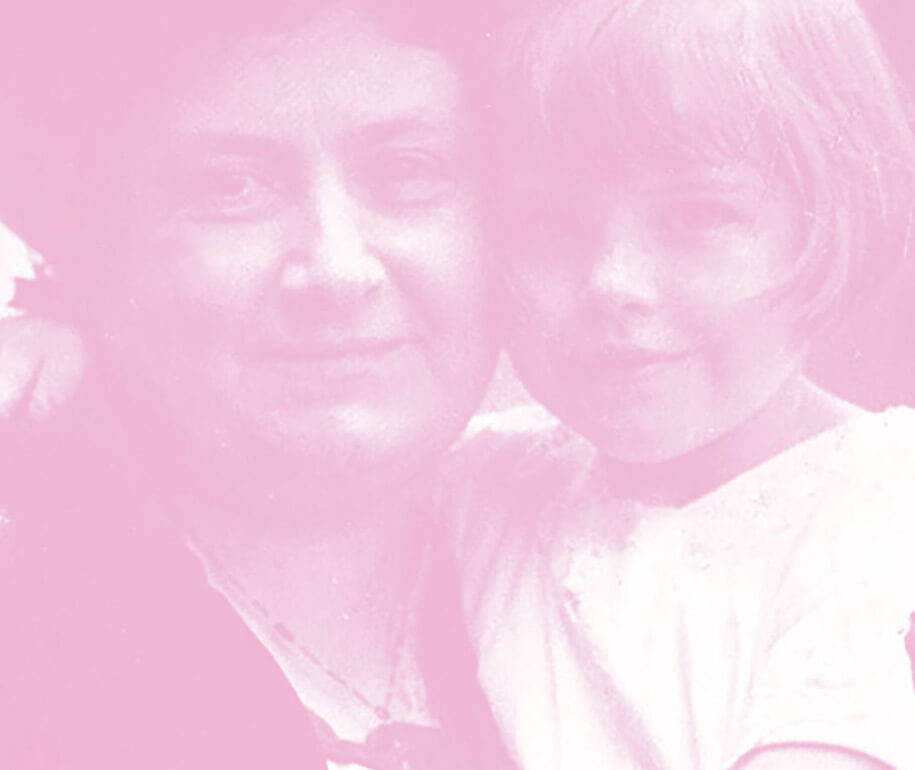Opening time
Openings and reservations in the TICKET section

![]()
![]()
A small, 130-square-meter, four-window apartment overlooking Mazzini Square. Here, at number 10, Maria Tecla Artemisia Montessori was born on August 31, 1870. His father Alessandro Montessori came from Ferrara to work as inspector at the local tobacco factory whereas his mother Renilde Stoppani, born in the nearby Monte San Vito, belonged to a family of small landowners. After a long restoration, the rooms where she stepped in the very first years of her life – the founding time par excellence, according to her research – have become Casa Montessori Chiaravalle. A place that is ancient and contemporary at once, true to the lore and ready to be accessed and used anew.There is a sort of dialogue going on between the intimate mood of the house and the urban blueprint of education’s community-wide scope – between the Marulli palace hosting the municipal library and the nearby abbey with its monastery, both pointing at the sea together with the tobacco factory, and the hinterland-ward Chiaravalle Montessori Foundation plus a handful of Montessori schools. Monte San Vito stands in the distance, meaningful and iconic.
The House – set up with museum-like criteria, communication and display systems – keeps the veracious authenticity of an inhabited place at the first floor of an apartment building on the main square, where daily functions intertwine and overlap. Pivotal to the urban fabric, it speaks and communicates; it is a shining light and an open door becoming bigger and wider, an active subject in the cultural scene and to the public debate. It is the House made of rooms that becomes invention and project, experience and memory, a never-ending insight on Maria Montessori’s thought. This place tells the story of the woman, the mother, the scholar, the traveler, the scientist, the pedagogist connecting Chiaravalle to the world.
The project – cdesigned, supervised and written by Cristiana Colli – has enhanced access and usability methods by overcoming architectural barriers, thus diversifying and expanding the touring experience.A birthplace, a museum, a community within the community – virtual and real all at once – the whole House shines as a place of broad and unconventional knowledge, of meditation, contemplation, dissemination. Through contemporary tools and languages, the life and work of Maria Montessori are brought back as signs, exhibits, inspirations, and multicultural dialogues, connections among languages, geographies, worlds and disciplines. And so the House puts back together the maps of her existential and scientific quest to seize it all back, yet another homecoming after the October 1950 one, a year after her last trip to India when – at the height of success – her desire to see Chiaravalle again came true. During an unforgettable, soul-stirring event hosted by Mayor Molinelli, the greatest honors were bestowed upon her. She would say to her son Mario: “Now I’m happy, even if I die I have seen my hometown again”. Born on the Adriatic Sea, Maria Montessori would die on the North Sea, in the Pierson family’s holiday home in Noordwijk aan Zee on May 6, 1952.
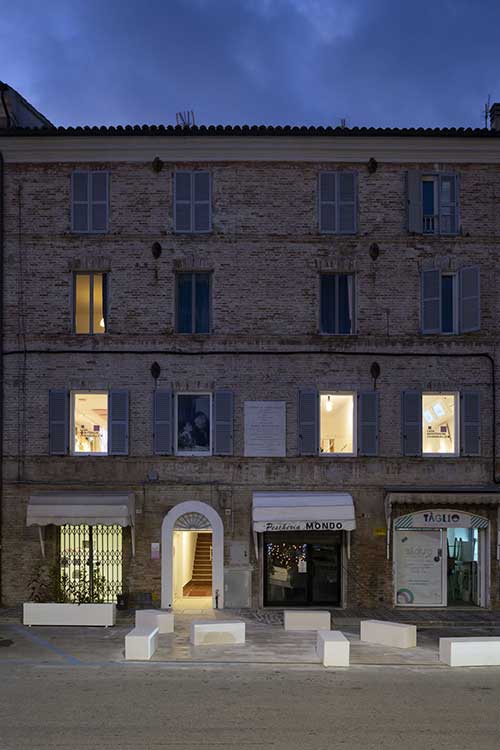


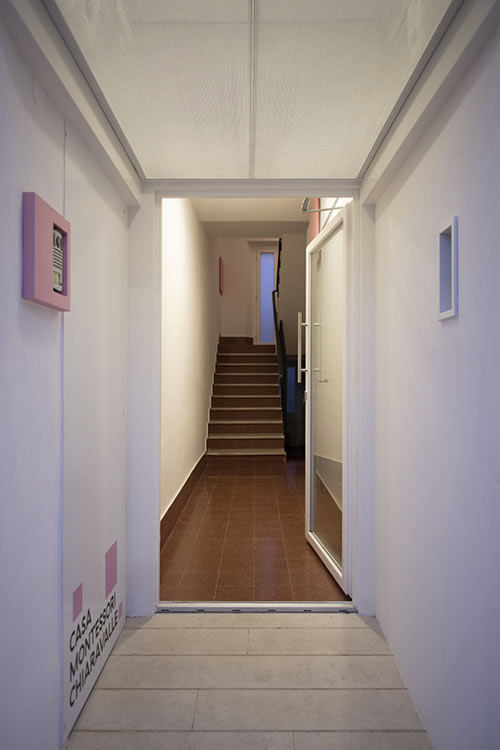


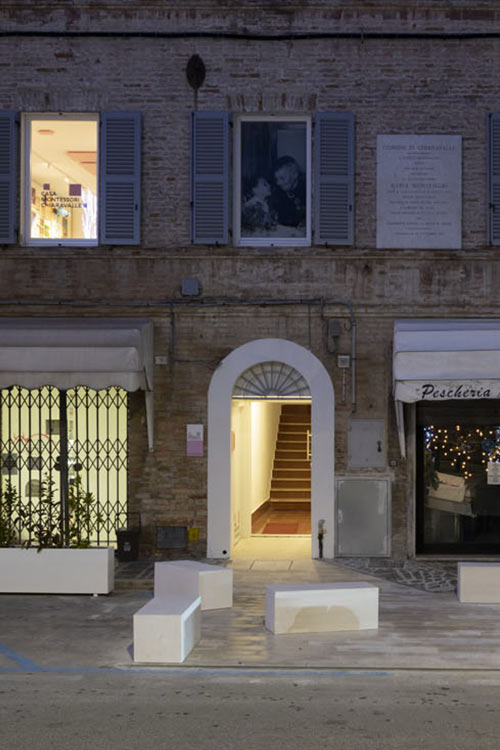











Casa Montessori Chiaravalle is the birthplace soaking up the tales of the many real and symbolic places that welcomed and greeted Maria Montessori: steamers, schools, manors, parliaments, universities. Everything happened in that tiny little space with windows like screens and spyholes staring at the outside world, at that native community where an amazingly human, scientific and intellectual story came to life. Her house stands as a space of public intimacy, with the remnants of ancient rooms that welcomed her steps and all their belongings acting as fragile and poetic signs of her. This is the sight of education caught through the very objects and principles laying at the core of her Method and the roadmap of her existence – a whirlwind of meaning, stories and places.
The upgrade and redevelopment project by PLA/STUDIO (Emanuele Marcotullio, Giacomo Barchiesi, Andrea Antognozzi, Mattia Rebichini) relies on a well-thought mix of museum display systems, interactive multimedia and tactile communication so as to offer a world-like feel while remaining consistent with the small size and “domestic” nature of the space. The thematic break-down of the house by rooms has a quote-like and place-identity feel to it, alongside a desire for intimate and personal use. An inside / outside dialogue device, a catalyst of themes and relationships between Chiaravalle and the world made up of dedicated and intertwined centralities. Thus, Maria Montessori’s immanence goes beyond commemoration to become one with the community backbone and the public space through an integrated and intelligible project of synchronic acts where everything speaks volumes – the facade, the windows, the terrace, the staircase, and the sidewalk. The House and all therein are designed to be open, flexible and scalable as for their content, story and representation.
The life of Maria Montessori unfolded as worlds and horizons were passing by – she was born in candlelight and died at the eve of space conquest. She was one of the first Italian women to graduate in Medicine, the single mother of Mario Montesano Montessori, the scientist who applied the discoveries made with disabled children to the whole childhood universe, a woman committed to female emancipation, equal wage, human rights and universal suffrage, a free thinker who claimed the independence of knowledge and education with respect to all forms of ideology and totalitarianism.
She was full of energy, passion and curiosity, she strived for knowledge and inclusion. She travelled around the world by all means and built bridges and connections between West and East. She soaked in, merged and shaped cultural influences into a “cosmic education” program aimed at guiding children’s growth and the progress of mankind as a whole. Maria Montessori was the absolute star of the pedagogical, scientific and philosophical scene of the twentieth century – and then some. Her life choices and multicultural approach, her connection with scientific literature and the international milieu – with a special focus on the re-educational experiments of Jean Marc Gaspard Itard and the work of Édouard Séguin – paved the way to her Method for the free expansion of individuality, a renowned pattern that has been adopted for over a century all around the world, wherever a high-profile educational concept called for it. A truly pioneer as for the nature of cognition, learning and socialization models, she supervised the practical and theoretical training of teachers through essential programs and texts that helped in promoting the Method in thousands of Children’s Houses – a format thought for the San Lorenzo projects in Rome and then launched in all continents, from nursery schools to kindergartens, from primary to secondary schools. Maria Montessori has been a much-acclaimed, authoritative and passionate cosmopolitan character admired by the likes of Gandhi, Freud, Tagore, Piaget, and Edison. She lived in Italy, United States, Spain, Netherlands and India. She shared her knowledge for the assertion of children’s rights and a balanced development of society. She was a three-time nominee for the Nobel Peace Prize.
Geographically speaking Maria Montessori’s life took on a planetary scale whereas, as far as history is concerned, she stood at the centre of the twentieth century development and civilization processes. The influence of her work, the range of her interests and achievements, the Method and her ethical commitment, her travels, relationships and experiences connected different places and disciplines, communities, social models, cultures and worldviews. Maria Montessori lived through the leaps of history and lifestyles, from the Belle Époque buoyancy to the development of arts, she met the powerful and the wise, crossed many continents, travelled on steamers and got a glimpse of the visionary power and the promise of future of the first marconigrams. To give the full scale of her true dimension and connections, a map should become infographic, multi-vision, installation.
Created in 1946 by American architect Richard Buckminster Fuller, the Dymaxion planisphere is a democratic, groundbreaking, radical map with no given hierarchy where the representation of the globe is less crooked and distorted compared to other depictions. The life and times of Maria Montessori spun around this very worldview: the story of a woman sparking among extraordinary events, two World Wars, dictatorships scarring the conscience of many, the rise and fall of ideologies, the progress of scientific knowledge and the relativization of value systems up to the dawn of consumer society.
The map is linked to six videos representing interpretation criteria: private life, public life, the twentieth century, Chiaravalle, the Children’s Houses, the internationality of thought and action. A key provides a frame for topics and information with shapes, paths, codes and colours. Before us, we have a few items – clothes and documents – recalling her private life, historical editions of her works, gifts from many trips, and the public witness of a life larger than life.
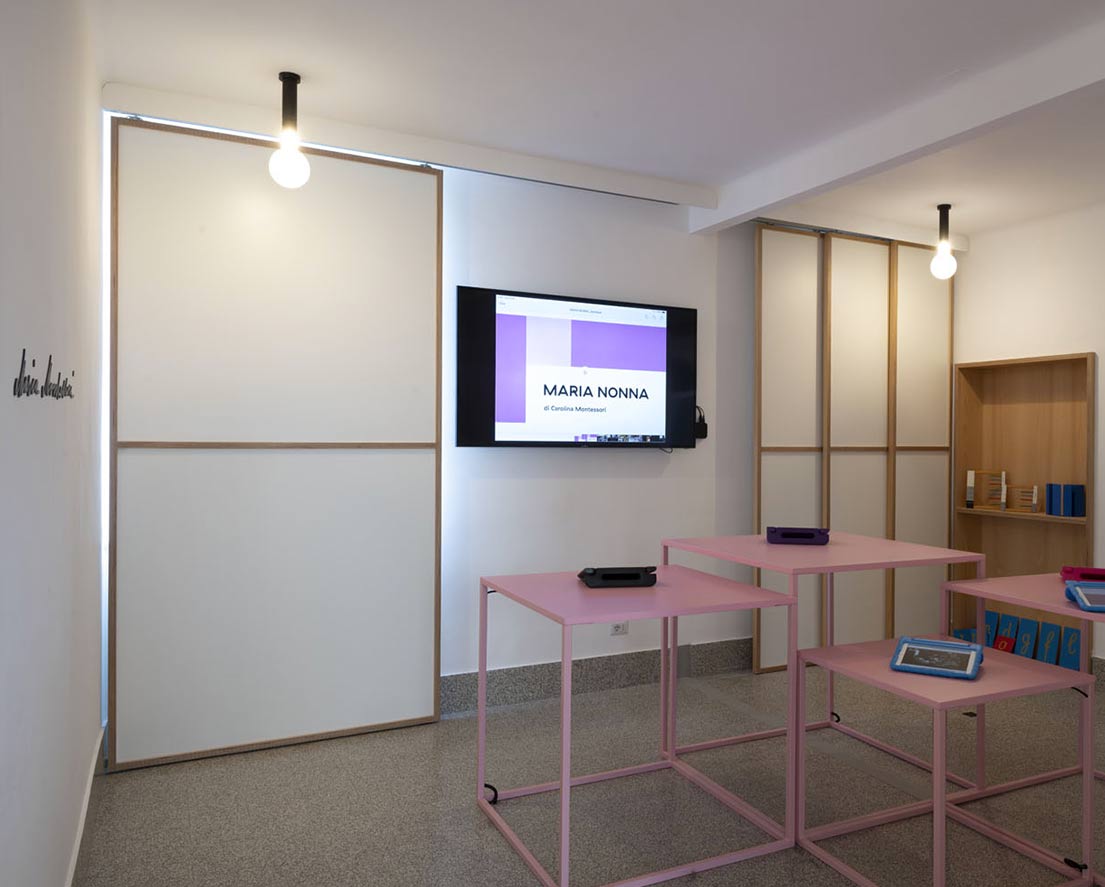

Multimedia classroom, storage, lab of new experiments related to knowledge, learning and content production. It is the technology that diversifies the use, alone or together – video walls, individual access devices, iPads. An on-demand catalog constitutes the first nucleus of in-depth studies that are constantly updated and produced – podcasts, period films, documentaries, audio and video interviews, archival documents. The plurality of sources is access to multicultural knowledge in the spirit of curious attention to the things of the world, which welcomes a precious teaching of Maria Montessori.
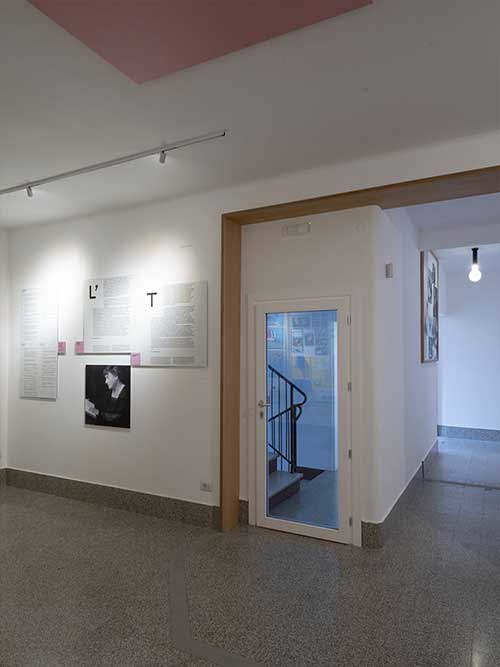

Human mind, in fact, takes hold of the world by giving it structure and orders it according to formal categories such as distinction, discrimination, comparison, measurement, classification, seriation and generalization.
In the Room, the only picture on display is that of the legendary glass-walled classroom, the iconic demonstration classroom brought to the Panama-Pacific International Exposition in San Francisco to show the world a revolutionary educational proposal. The set-up by architect Louise Brigham would accommodate about thirty children, aged three to six, from several countries and with different linguistic and socio-cultural backgrounds who had been chosen from a list of over two thousand applicants.
The Montessori Demonstration Class rolled out on August 6, 1915 and that day became the “Montessori Day”: over the next four months, an enthusiastic audience made up of parents and worldwide education specialists was given the opportunity to contemplate the higher qualities of a human being spontaneously manifesting themselves in the children of that classroom – self-composure, precision, prolonged attention, autonomy. Education was a real sight.
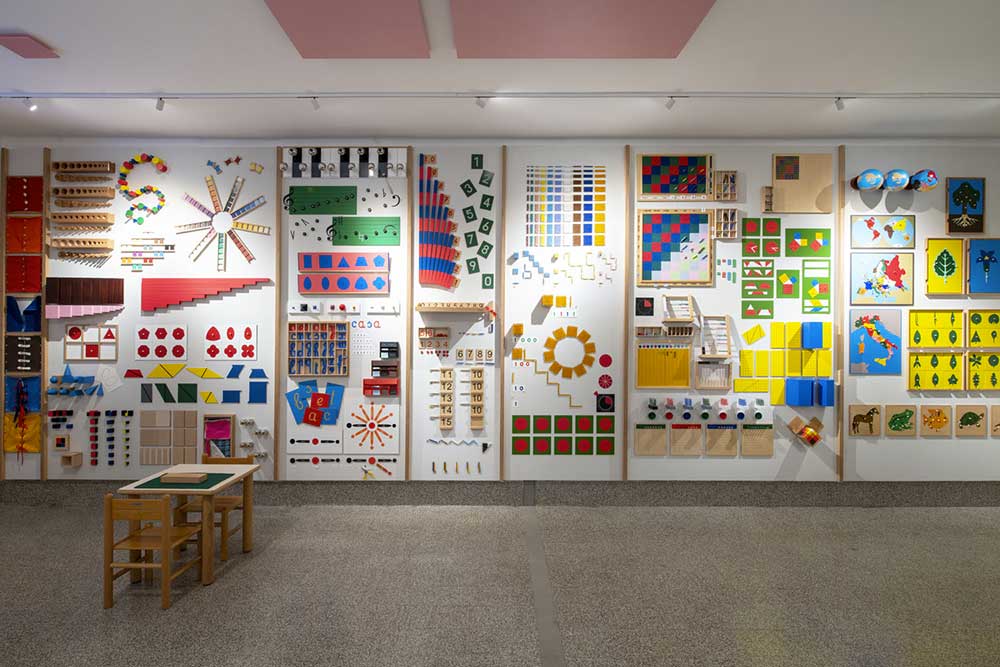

This apartment, which for decades has been an archive and study center, is recognized by scholars and enthusiasts as a place of research and knowledge. In the refurbishing of space, maintaining this dimension takes on the sense of immersion in the Montessori universe through some fundamental publications and first editions, Montessori and general pedagogy texts, in permanent dialogue with new contents and the entire archive in the Library.
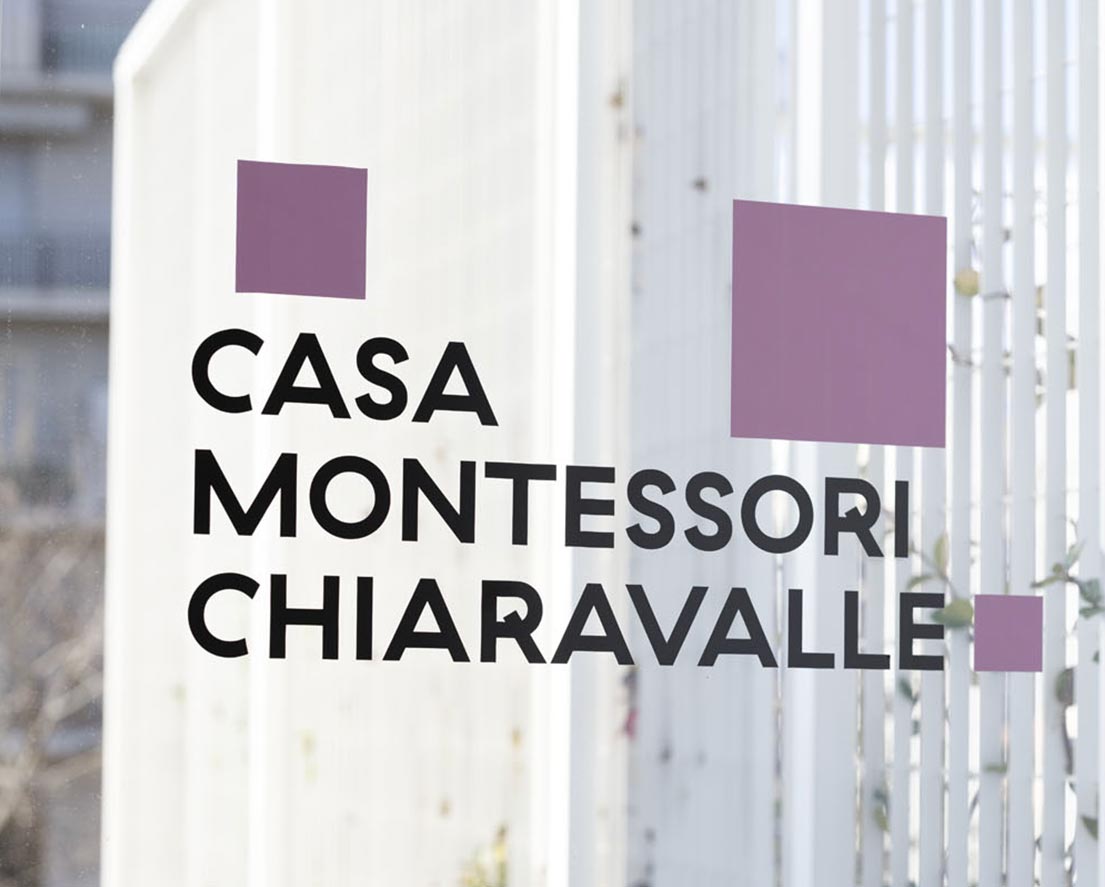

An open, essential Room, marked only by the green perimeter, the sky and the tubs with tulips by Maria Montessori – the same ones that bloom on her tomb in Holland. It is an unexpected opening that marks the many metamorphoses of a building, and at the same time it is a glimpse of light, a different dialogue with the city.
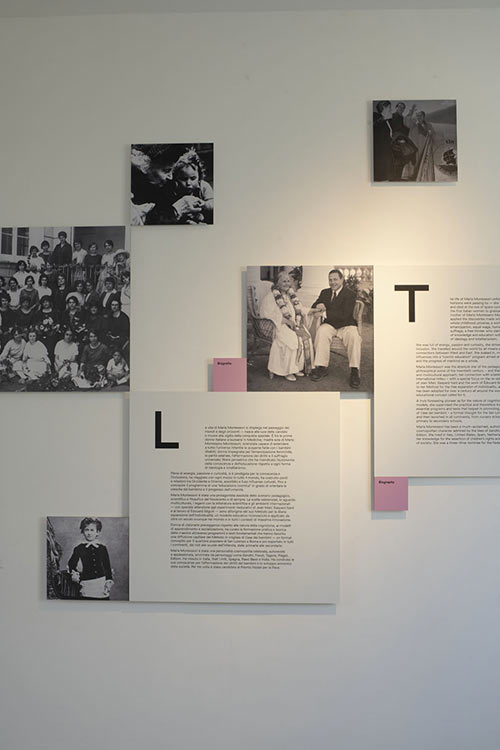

The visual concept by CH RO MO: Chris Rocchegiani and Roberto Montani is inspired to one of the most iconic learning materials: the pink tower. The artwork recalls the classic visualization of a child building the tower again and again with ordered gestures so that each of those pieces – organized and understood – falls back to its place. It is made up of 10 cubes sized from 1 to 10 centimeters and arranged on a smallest-to-biggest mathematical scale. This also inspired the brand study and the coordinated image that turned the scale two-dimensional into a dynamic, infinitely-scalable artwork for display applications, merchandising and print formats.
The different-sized pink squares coexist and occupy the space in a way that is casual and orderly at the same time, hinting at a strict play where fun is one with order.
This choreography of shapes complying with the color palette of Montessori materials is topped by a special typeface: GT Haptik, a monolinear grotesque font designed on a tactile, non-visual basis between 2009 and 2014 by Reto Moser and Tobias Rechsteiner for the Grilli Type Swiss foundry.This was meant to be legible with closed eyes, by the bare touch of the hand.
A notion that is all the more consistent with the attention Maria Montessori paid to the different forms of knowledge and learning along her whole research. Starting with the most special one, the hand experience.
Cristiana Colli
Curator of the requalification project of Casa Montessori Chiaravalle
